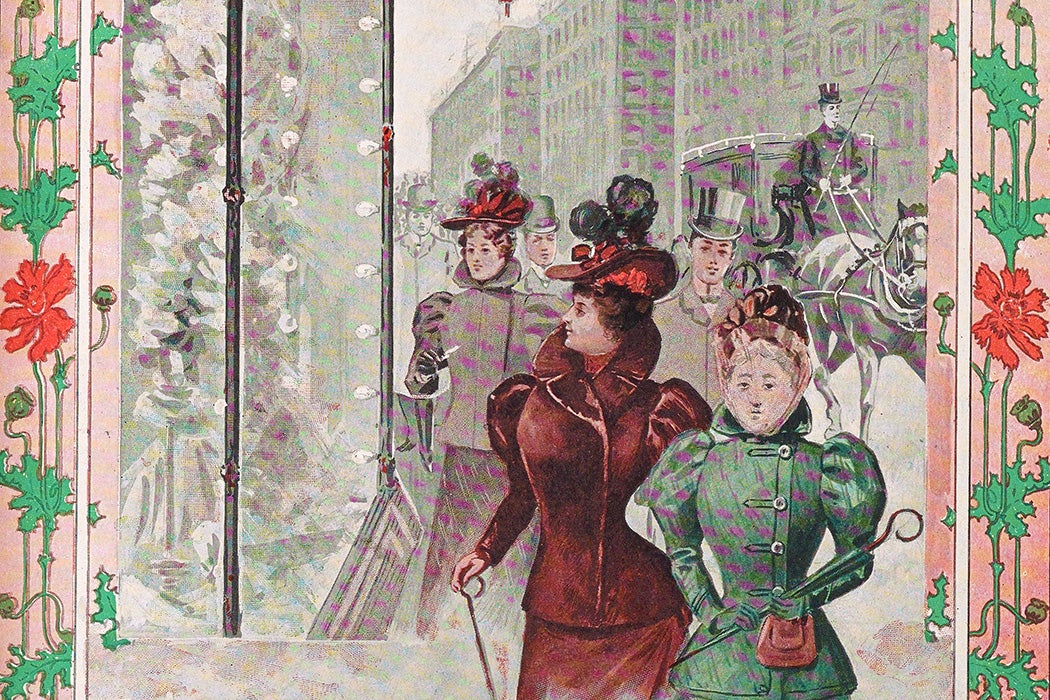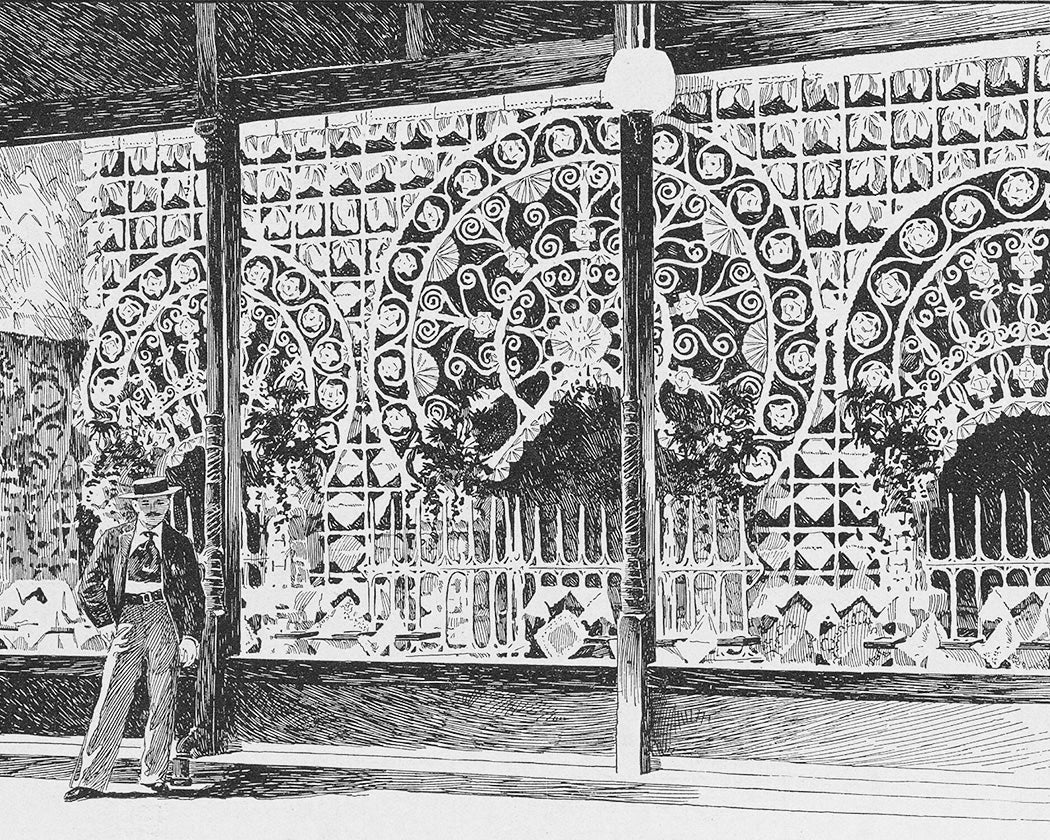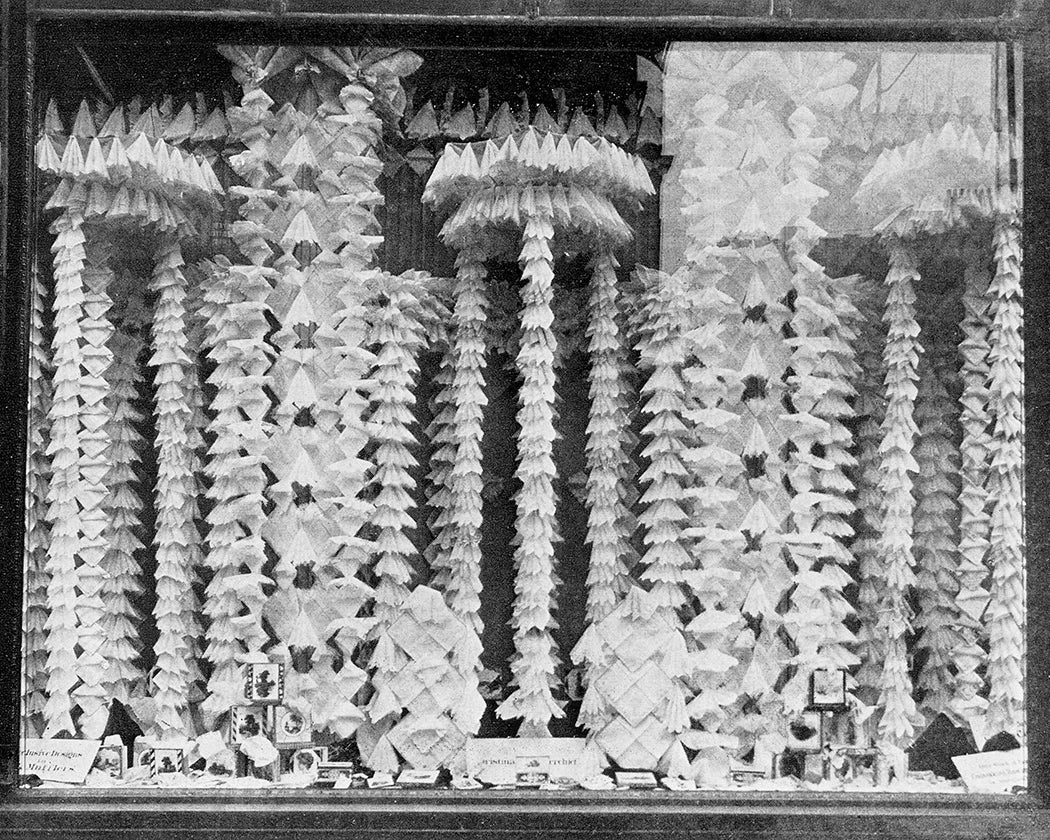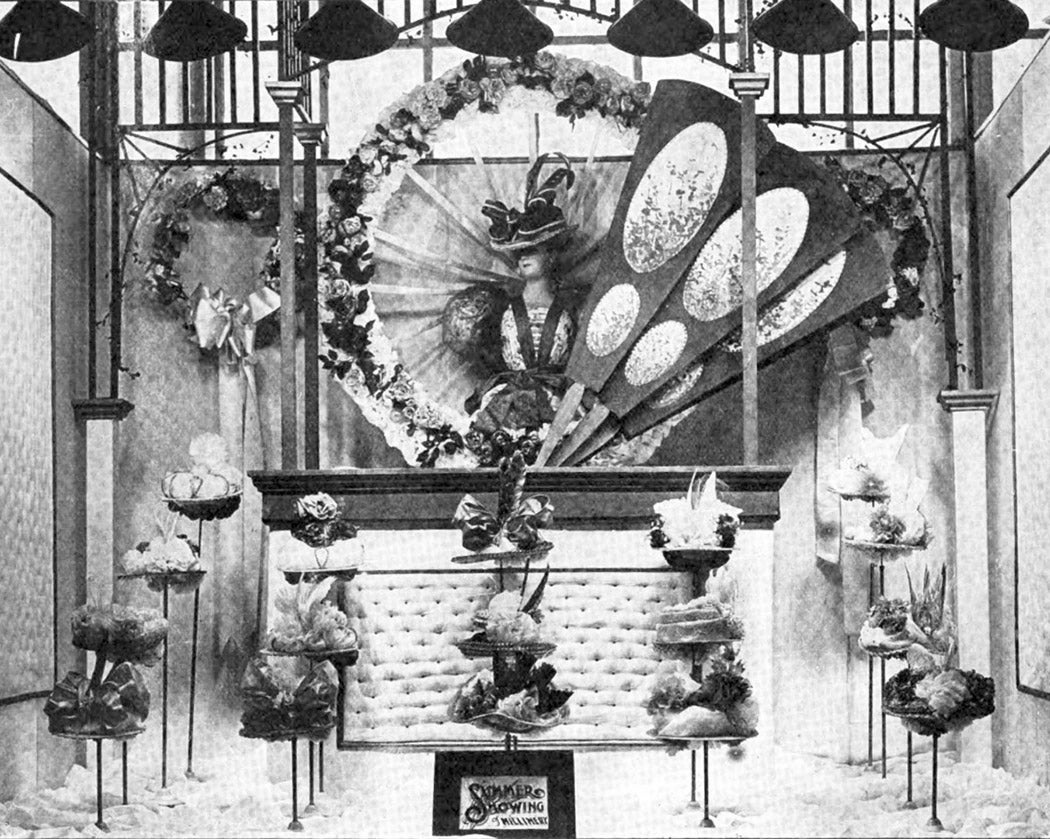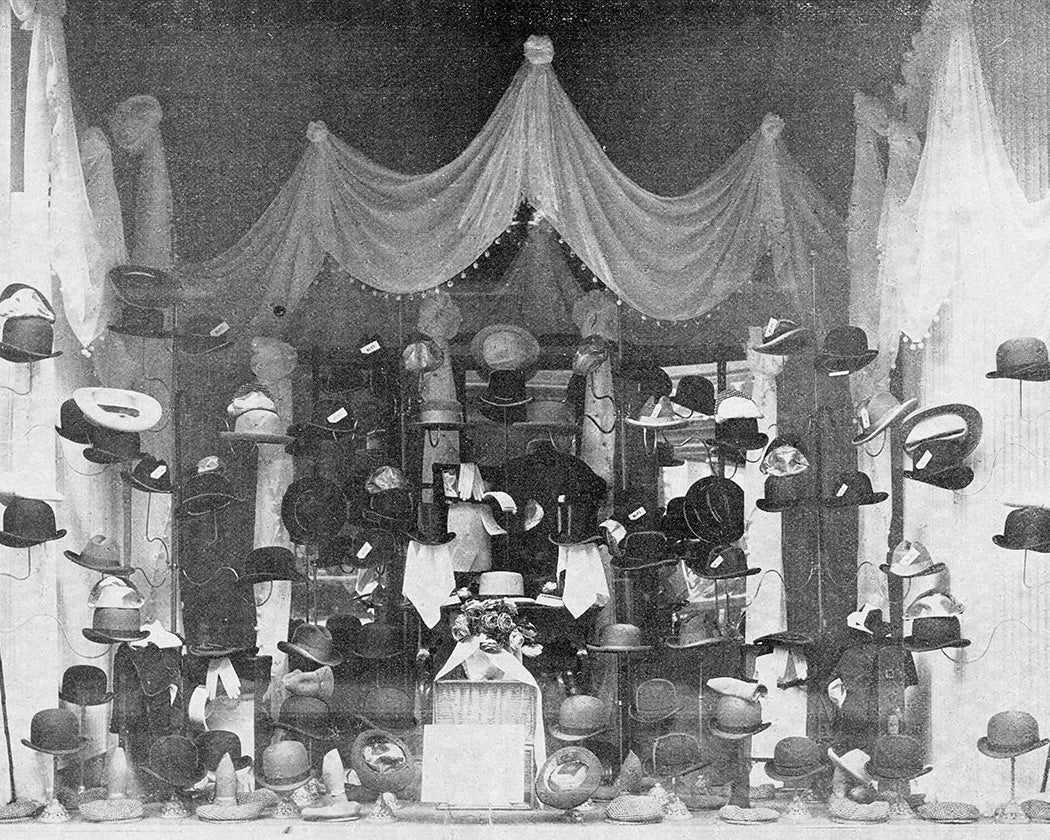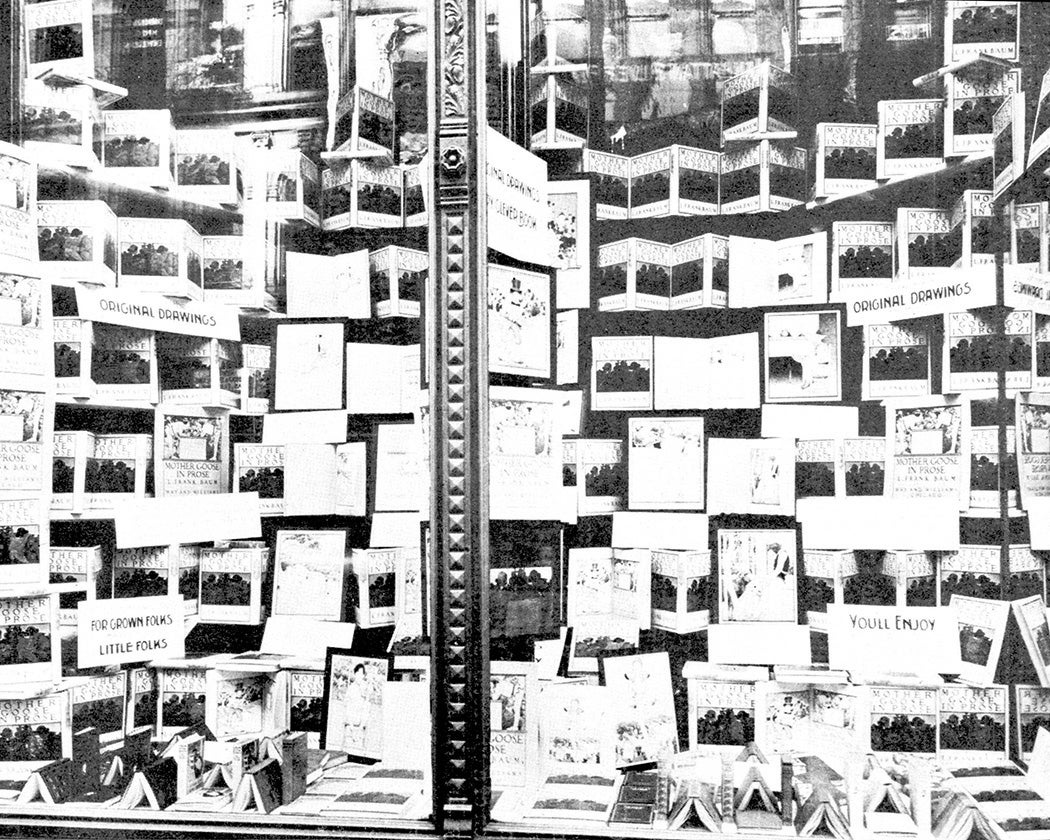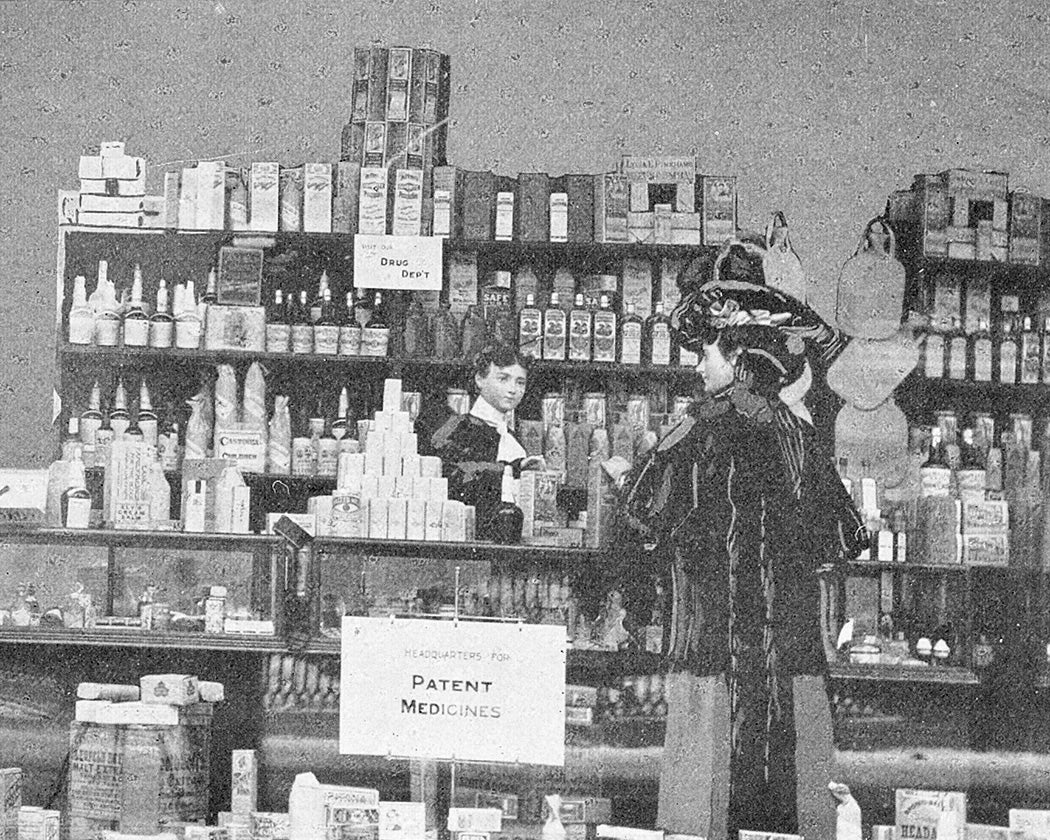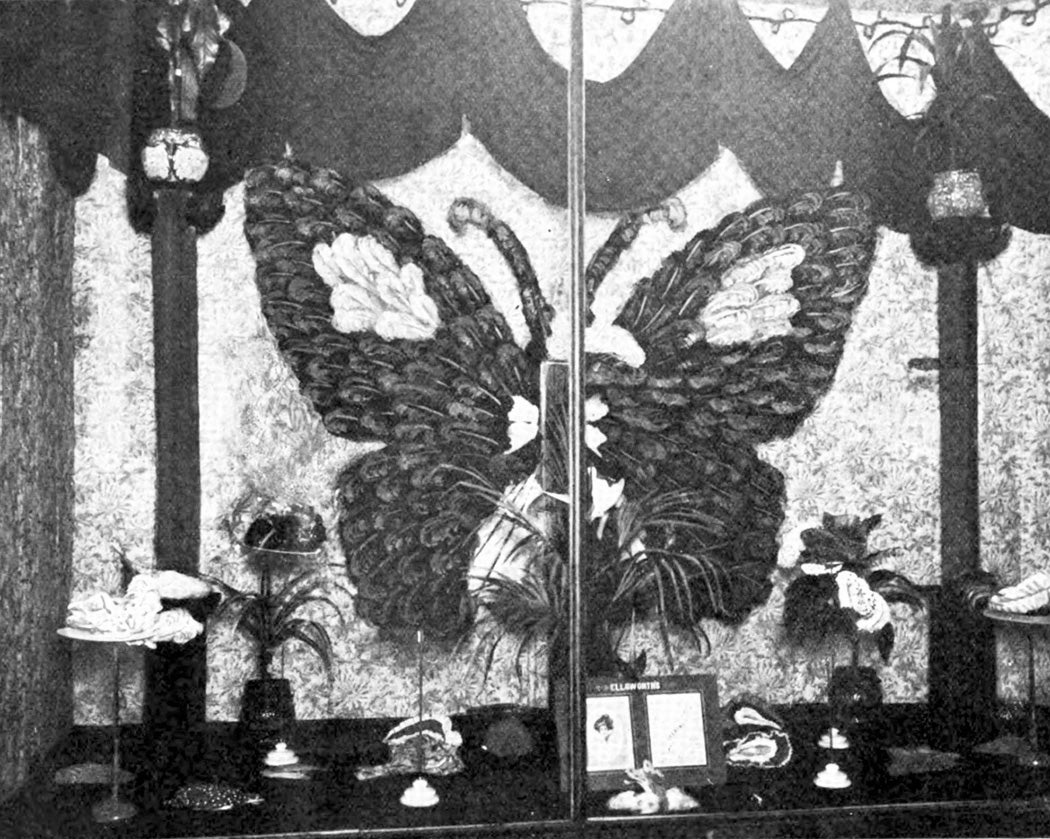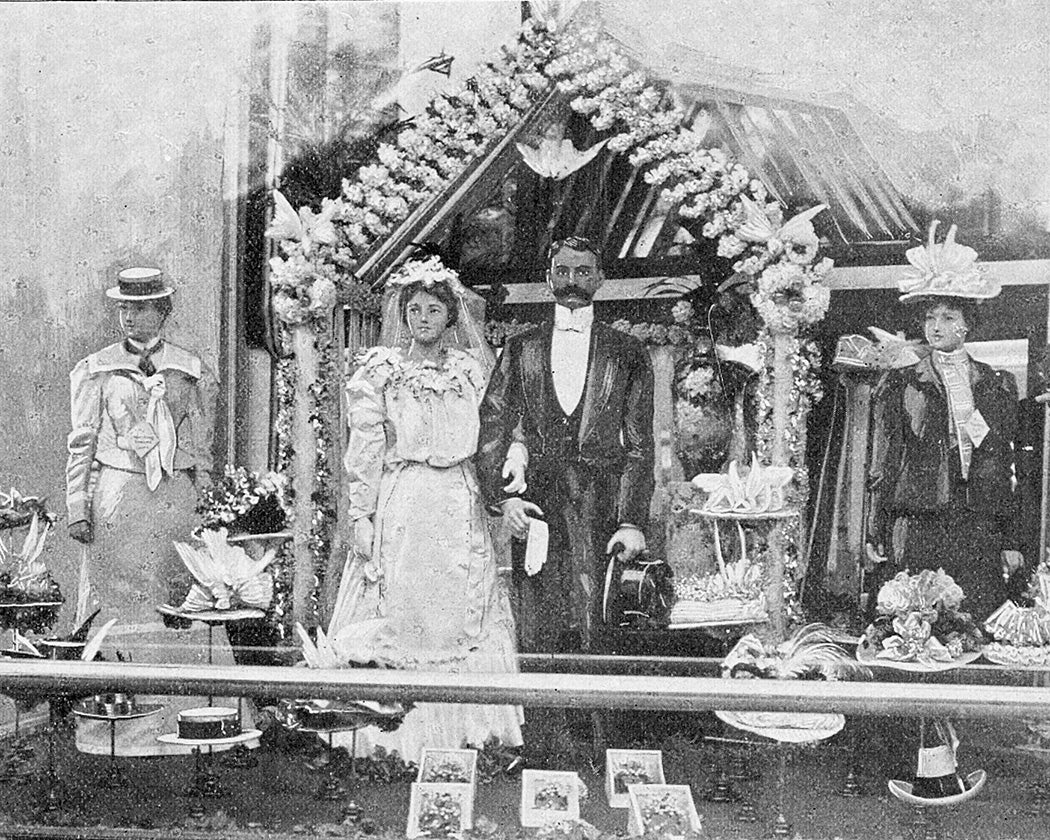“Many shops stood in the street, and Dorothy saw that everything in them was green. Green candy and green pop-corn were offered for sale, as well as green shoes, green hats and green clothes of all sorts. … Everyone seemed happy and contented and prosperous. … they came to a big building, exactly in the middle of the City, which was the Palace of Oz, the Great Wizard.” – L. Frank Baum, The Wonderful Wizard of Oz
At the turn of the twentieth century, in a department store window in Sacramento, the head, neck, and shoulders of a young woman floated, bodiless, above a pedestal. She jutted out her square jawbone, showing off an elaborately festooned head piece. At regular intervals, the woman sank into the pedestal, and vanished. When she re-emerged, she wore a new millinery concoction. Shoppers gathered on the sidewalk to marvel at the “vanishing lady,” gazing in awe as she disappeared and then reemerged. They crowded against the glass so forcefully the owners had to install iron bars to prevent the windows from shattering.
Who was this woman? Where was the rest of her? Who were the window-gazers, staring at her fleshless body with such longing? And who engineered the display to attract all these passers-by? Although many have attributed the display in Sacramento to L. Frank Baum, Amy Reading has discovered that it was the work of Chas. W. Morton, who invented the display for the Weinstock, Lubin & Co. department store, where he was the head window trimmer.
Weekly Newsletter
Lyman Frank Baum, the seventh of nine children (only five of whom lived to adulthood), was born in 1856 and raised on his family’s estate, Rose Lawn, in Chittenango, New York. His father, a banker and industrialist, had made a modest fortune in refining oil in Pennsylvania, but Frank yearned for more artistic pursuits. Institutions never suited him—his parents sent him at age 12 to Peekskill Military School, where he suffered from health problems said to be heart related, and returned home two years later, never completing formal schooling. He cajoled his father into buying him a printing press, and with the help of his younger brother, Harry, launched several short-lived publications, including The Rose Lawn Home Journal and The Stamp Collector. Baum’s first business enterprise was breeding fancy fowls—in the 1870s, designer chickens were having a moment—and he had a meteoric rise to the top of the world of poultry show competition. Indeed, Baum’s first commercial book, published in 1886, is a monograph on what he considered the fairest breed: The Book of the Hamburgs: A Brief Treatise Upon the Mating, Rearing, and Management of the Different Varieties of Hamburgs.
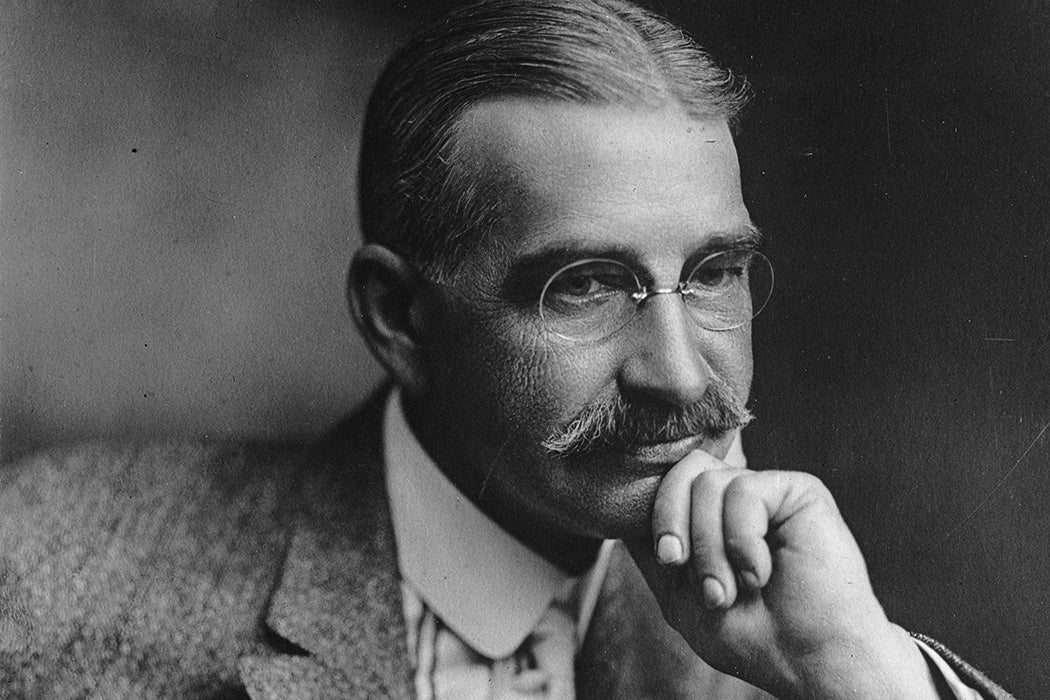
But Baum was a polymath and had flown the coop about five years earlier to try his hand in the theater. He wrote and starred in original Irish melodramas like The Maid of Arran. Most of his early shows either never got produced or flopped, yet Baum did find one lasting success from this early-career theater: he met and married Maud Gage, the daughter of a Matilda Joslyn Gage, who had won renown as a leader in both the suffragist and abolitionist movements. In 1888, at age 32, Baum switched paths yet again, when he moved with his family to Aberdeen, South Dakota, where his wife’s relatives owned land. There, he founded Baum’s Bazaar, a dry goods store modeled on Woolworth’s, which Baum had revered growing up. An enormous plate-glass window dominated the Bazaar’s storefront, not just displaying the toys, bicycles, and candlesticks inside, but offering a show unto itself. Children flocked to the store to ogle the dazzlingly stacked wares. Tantalizing customers was only the beginning: Baum’s best illusions were still to come.
Department stores offered Baum both content and capital for his burgeoning writing career. To drum up interest for the Bazaar, Baum did what he’d been doing since childhood: used a small printing press to publish advertising bulletins. In 1890, Baum bought out a local newspaper, the Dakota Pioneer, renamed it the Aberdeen Saturday Pioneer, and stuffed it with entertaining social columns. Baum used the Pioneer to champion women’s rights in both satirical columns (writing as the spicy “Our Landlady”) and impassioned editorials. His views on Native Americans, however, are controversial at best and often considered racist at first glance, according to writer Hunter Liguore. Upon the death of Sitting Bull, Baum wrote that “the best safety of the frontier settlements will be secured by the total annihilation of the few remaining Indians.” Critics such as archivist Tammy O’Rear argue these editorials irreparably tarnish Baum’s reputation. Others, however, are more generous: historian Gretchen Ritter argues that Baum saw Native Americans like Sitting Bull as “noble savages” who died courageously fighting for their people, while he considered those who were willing to be resettled, he wrote, as “whining curs who lick the hand that smites them.”
When economic crisis hit Aberdeen in 1891 it plunged both the store and the Pioneer into bankruptcy. Baum responded by moving with Maud and their four children yet again, this time to Chicago. In the Windy City, the retail landscape was chaotic. Growing tensions between union workers and store owners left the latter surpluses of inventory. Many store owners moved these extra goods into thoughtless heaps throughout their premises. Baum had a better idea: he made these surpluses alluring, displaying them as objects of desire. As historian Susan Mizruchi puts it, “Window displays were narrative enactments designed to entrance potential consumers as if they were spectators at a theater.” In other words, for Baum, window displays were an extension of his writing: a dramatic, glamorous, unbelievable, entrancing way to tell an entertaining story.
As he had previously, Baum codified his expertise into the written word. In 1897, he launched The Show Window, a trade periodical. Vividly illustrated, it instructed shop owners in the smoke-and-mirrors, lipstick-on-a-pig approach to selling wares: as long as goods are displayed elegantly, it doesn’t matter what is being showcased. “People will always stop to examine anything that moves,” Baum wrote. Highlight the “possibilities lying dormant in the beautiful goods,” he advised, adding that correct framing will move merchandise even if it’s “old enough to have gray whiskers.” The next year, he took his interest a step further and founded the National Association of Window Trimmers.
In 1900, Baum published two books. The Art of Decorating Dry Goods Windows and Interiors, a bible for those in the trade. It established him as the country’s leading window trimmer. Image-heavy, the volume includes diagrams detailing proportions for proper display layouts, explanations for how to engineer illusions, and lavish photographs of model windows from across the country. There’s a window for every occasion, and a trick to ensnare gazers.
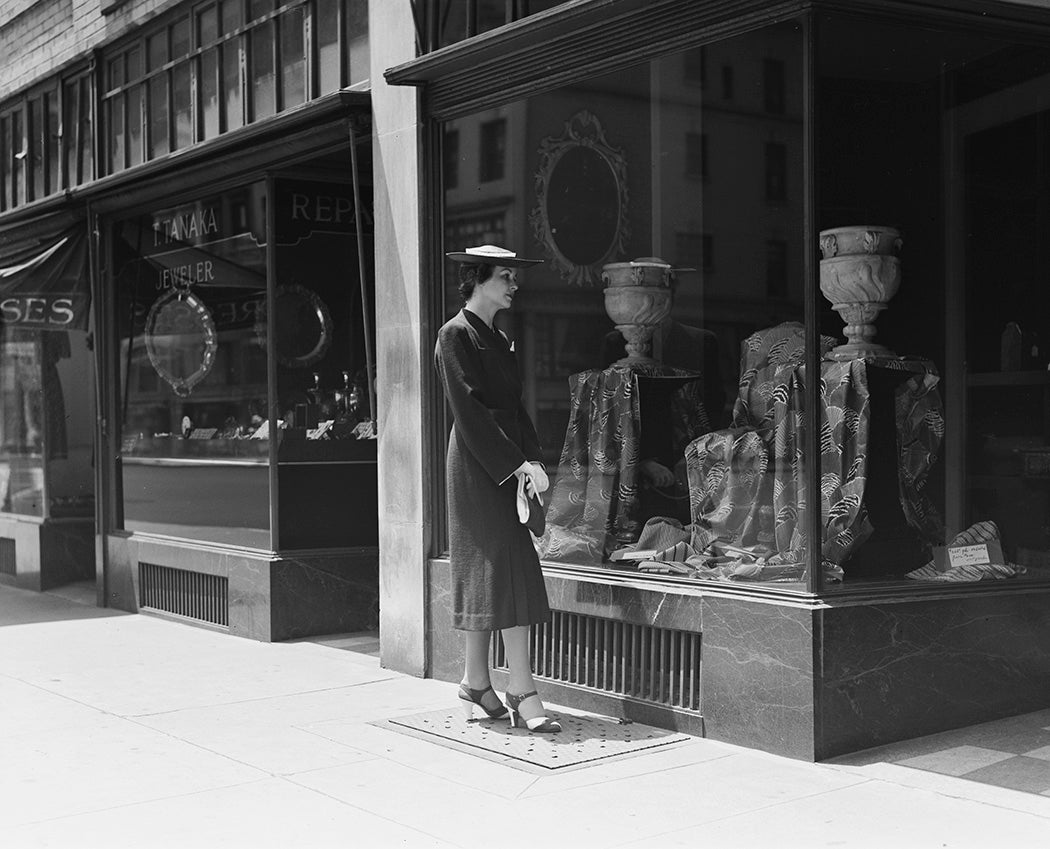
On July Fourth, for example, novice trimmers tended to point an electric fan at the flag to make it wave. Baum admonished this practice. It “is not a natural method of waving Old Glory,” he wrote, “The sweep of the flag pole itself is the proper method of waving the star spangled banner”—an effect, he assured the reader, that a show window can easily create. Indeed, Baum gave step-by-step instructions for just how to do it. There is also a photo of a show window with Baum’s spinning Old Glory flagpole alongside mannequins in smart shirts and long skirts flanking an enormous, prop cannon. A column of straw boater hats hangs next to the display, perhaps as cannon fodder; bunting drapes across the ceiling in a headache-inducing funhouse collision of stars and stripes.
Beloved as Baum’s decorating book may have been by the cognoscenti, it was the second title he published that year which brought him worldwide fame. The Wonderful Wizard of Oz is every bit as much a theatrical production as Baum’s greatest window displays. It’s also a multipurpose symbol—ripe for a variety of interpretations.
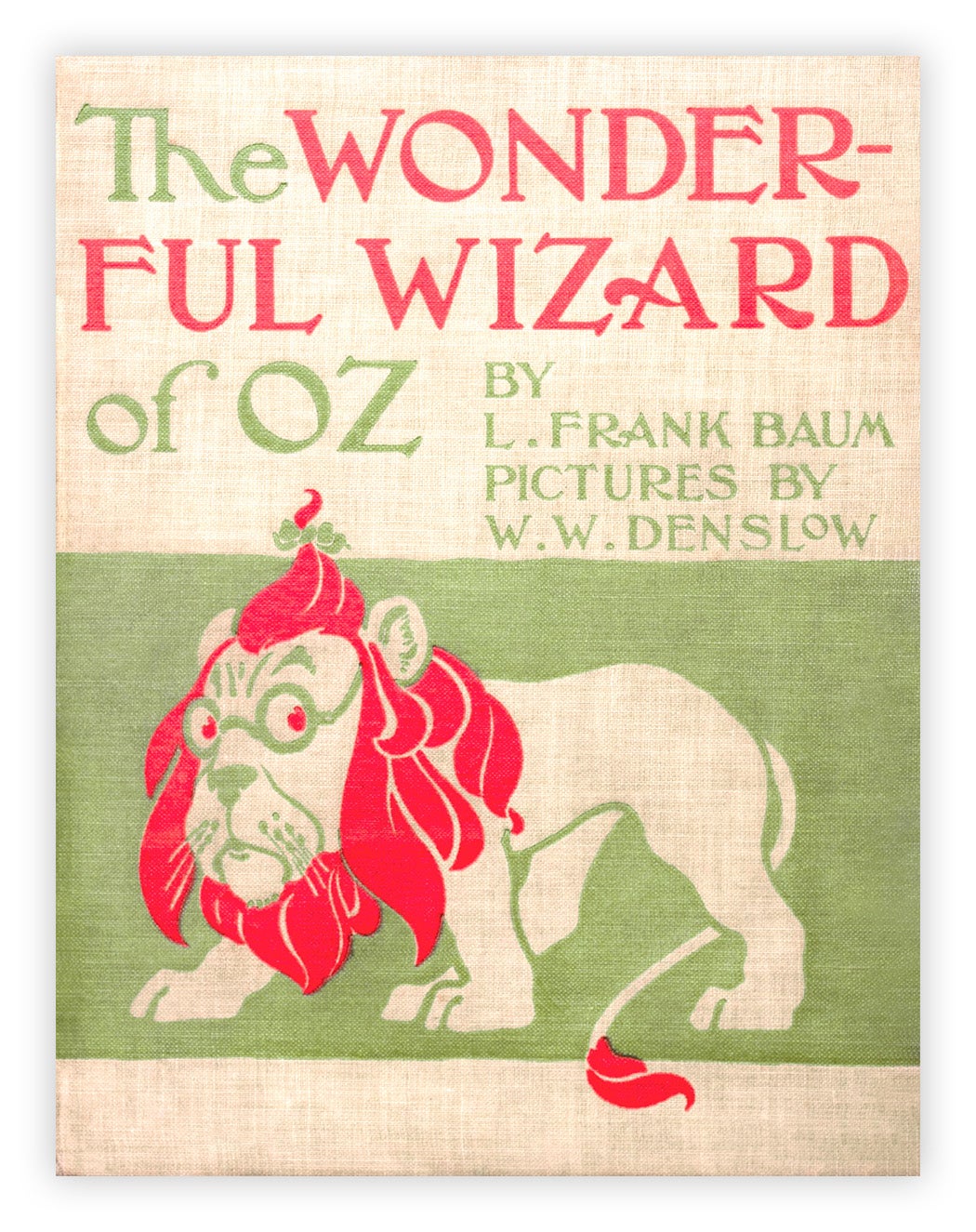
Henry Littlefield, a high school history teacher in suburban New York in the 1960s, understood the Wonderful Wizard of Oz as an allegory for late 19th-century monetary policy debate. Dorothy’s silver slippers (made ruby red in the Technicolor film adaptation) tripped along the Gold Standard of the Yellow Brick Road toward the Emerald City, a mirage built on cheap paper greenbacks that would soon crumble. “Oz,” in his reading, stood for “ounces,” the measurement for gold and silver. (Baum himself always insisted that the name came from a filing cabinet: one drawer was labeled A-N, the other, O-Z.)
Another popular reading has Oz stand in for Western expansion: the Wicked Witch of the American West gets crushed under all the settlers coming from the Eastern United States. The Winged Monkeys, in this reading, symbolize Indigenous peoples who must succumb to the Wizard’s power. The Emerald City is probably a riff on the White City, the glittering, perfect metropolis at the heart of the 1893 World’s Fair in Chicago.
But the Emerald City is nothing if not the greatest show window of Baum’s entire career. By understanding it as such, enticing Dorothy as well as Oz’s denizens with dazzling goods, The Wonderful Wizard of Oz establishes the department store both as a consumer magnet and as an essential anchor of urban living. Just as Baum established the field of shop-window dressing, the Emerald City established the prominence and importance of these glassy displays in art. Like any excellent show window, the Emerald City is both display and mirror: it’s a mesmerizing palace of consumption that shoppers can imagine inhabiting. As scholars such as Gary Totten and Anne Friedberg argue, the window has an outsized role in the female gaze, creating a mirror and a fantasyland. The myth the Wizard perpetrates—that is, the department store fantasy—is that Emerald City’s offerings are too powerful for Dorothy to regard without assistance. Of course, ultimately, it’s not the store itself that makes Dorothy see everything in green, but the tinted green glasses she’s told to wear to protect herself from reality—the most shocking experience of all.
Editor’s note: An earlier version of this article misidentified the location of the department store that featured the vanishing lady in its window. It was in Sacramento, not Chicago. The article also erroneously suggested that L. Frank Baum invented this display; in fact, the vanishing lady was the brainchild of Chas. W. Morton.
An earlier version of this article erroneously suggested that Baum’s views on Native Americans were blatantly racist. According to writer Hunter Liguore, Baum’s opinions were controversial and were more often thought to be racist only upon initial engagement with them.
